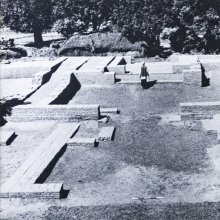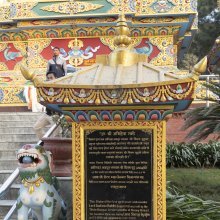Dvara, Dvāra: 31 definitions
Introduction:
Dvara means something in Buddhism, Pali, Hinduism, Sanskrit, Jainism, Prakrit, the history of ancient India, Marathi, Hindi. If you want to know the exact meaning, history, etymology or English translation of this term then check out the descriptions on this page. Add your comment or reference to a book if you want to contribute to this summary article.
Alternative spellings of this word include Dwar.
Images (photo gallery)
(+3 more images available)
In Hinduism
Purana and Itihasa (epic history)
Source: Wisdom Library: Skanda-puranaDvāra (द्वार, “gate”) refers to one of the fifty-six vināyakas located at Kāśī (Vārāṇasī), and forms part of a sacred pilgrimage (yātrā), described in the Kāśīkhaṇḍa (Skanda-purāṇa 4.2.57). He is also known as Dvāravināyaka, Dvāragaṇeśa and Dvāravighneśa. These fifty-six vināyakas are positioned at the eight cardinal points in seven concentric circles (8x7). They center around a deity named Ḍhuṇḍhirāja (or Ḍhuṇḍhi-vināyaka) positioned near the Viśvanātha temple, which lies at the heart of Kāśī, near the Gaṅges. This arrangement symbolises the interconnecting relationship of the macrocosmos, the mesocosmos and the microcosmos.
Dvāra is positioned in the North-eastern corner of the seventh circle of the kāśī-maṇḍala. According to Rana Singh (source), his shrine is located at “Saptavarana Vinayaka’s gate, CK 28 / 10”. Worshippers of Dvāra will benefit from his quality, which is defined as “the giver to the inner sanctum of Kāśī”. His coordinates are: Lat. 25.18662, Lon. 83.00830 (or, 25°11'11.8"N, 83°00'29.9"E) (Google maps)
Dvāra, and the other vināyakas, are described in the Skandapurāṇa (the largest of the eighteen mahāpurāṇas). This book narrates the details and legends surrounding numerous holy pilgrimages (tīrtha-māhātmya) throughout India. It is composed of over 81,000 metrical verses with the core text dating from the before the 4th-century CE.

The Purana (पुराण, purāṇas) refers to Sanskrit literature preserving ancient India’s vast cultural history, including historical legends, religious ceremonies, various arts and sciences. The eighteen mahapuranas total over 400,000 shlokas (metrical couplets) and date to at least several centuries BCE.
Vastushastra (architecture)
Source: OpenEdition books: Architectural terms contained in Ajitāgama and RauravāgamaDvāra (द्वार) refers to “door §§ 3.37; 4.26; 4.33.”.—(For paragraphs cf. Les enseignements architecturaux de l'Ajitāgama et du Rauravāgama by Bruno Dagens)
Source: Brill: Śaivism and the Tantric Traditions (architecture)Dvāra (द्वार) refers to the “doorways” (at each of the peripheral padas of the 9 by 9 deity map), according to the Devyāmata (chapter 105).—Accordingly, [while describing the consequences of a doorway]—“Thus, in due sequence, the consequences (dvāra—dvārāṇāṃ phalam) of doorways are given. [...] After learning the features of doorways (dvāralakṣaṇa) as described, specifically, the wise man should carefully establish a doorway with ample good qualities”.
Note: While these are the consequences for doorway positions in a residence for ascetics, the consequences do not fall on the ascetic residents themselves, but on the patron who commissions and funds the building of the residence, and who gains the benefit from it. So, the consequences are not in any way to be connected to the lives of the residents. None-the-less, it is worth noting that these are the same consequences that we see repeated over and again for domestic buildings of all sorts. The model that is being used is that for normal housing.

Vastushastra (वास्तुशास्त्र, vāstuśāstra) refers to the ancient Indian science (shastra) of architecture (vastu), dealing with topics such architecture, sculpture, town-building, fort building and various other constructions. Vastu also deals with the philosophy of the architectural relation with the cosmic universe.
Shaktism (Shakta philosophy)
Source: Google Books: ManthanabhairavatantramDvāra (द्वार) refers to the “door” (of a house), according to the Ṣaṭsāhasrasaṃhitā, an expansion of the Kubjikāmatatantra: the earliest popular and most authoritative Tantra of the Kubjikā cult.—Accordingly, “The man of knowledge should mark the sacred fields located in the towns. Thus (this) category has been explained externally; now listen (to how it is) in the home. Prayāga is in the middle (of the house). Varuṇā is present in the door [i.e., dvāra]. Kollāpura is in the scissors. The stove is Aṭṭahāsaka. One should know that the threshing floor is Jayantī and Caritra is the mortar (in which grain is cleaned or threshed). The winnowing fan is said to be Ekāmraka and Devikoṭa is the grinding stone. (Thus there are) the dish (used to cover water jars), the bedstead, mortar (muśala), threshold, stove, winnowing fan and grinding stone. [...]”.
Source: Brill: Śaivism and the Tantric Traditions (shaktism)Dvāra (द्वार) refers to the “entrance (of a temple)”, according to the King Vatsarāja’s Pūjāstuti called the Kāmasiddhistuti (also Vāmakeśvarīstuti), guiding one through the worship of the Goddess Nityā.—Accordingly, “[...] I approach the great temple of goddess Mṛḍānī that opens to the west (paścima-dvāra). It is guarded outside by Indra and the other [gods who guard the directions], and shines beautifully with utmost richness. I venerate the young elephant-faced master of Śiva’s gaṇas, the destroyer of obstacles. His lotus-hands are decorated with a noose, goad, fruit, and lotus. [...]

Shakta (शाक्त, śākta) or Shaktism (śāktism) represents a tradition of Hinduism where the Goddess (Devi) is revered and worshipped. Shakta literature includes a range of scriptures, including various Agamas and Tantras, although its roots may be traced back to the Vedas.
Kavya (poetry)
Source: Brill: Śaivism and the Tantric Traditions (kavya)Dvāra (द्वार) [=Dvāratā?] refers to a “door (to beatitude)”, according to Kālidāsa’s Raghuvaṃśa verse 8.88-90.—Accordingly: “The wise say that death is the natural state of embodied creatures and life is a change in that state. If a being remains breathing even for a moment it is surely fortunate. The foolish man regards the loss of his dear one as a dart shot into his heart. Another man looks on the same as a dart that has been pulled out, for it is a door to beatitude (kuśala-dvāratā). When we are taught that our own body and soul unite and then separate, tell me which wise person should be tormented by separation from the external objects of the senses?”.

Kavya (काव्य, kavya) refers to Sanskrit poetry, a popular ancient Indian tradition of literature. There have been many Sanskrit poets over the ages, hailing from ancient India and beyond. This topic includes mahakavya, or ‘epic poetry’ and natya, or ‘dramatic poetry’.
Ganitashastra (Mathematics and Algebra)
Source: archive.org: Hindu MathematicsDvāra (द्वार) represents the number 9 (nine) in the “word-numeral system” (bhūtasaṃkhyā), which was used in Sanskrit texts dealing with astronomy, mathematics, metrics, as well as in the dates of inscriptions and manuscripts in ancient Indian literature.—A system of expressing numbers by means of words arranged as in the place-value notation was developed and perfected in India in the early centuries of the Christian era. In this system the numerals [e.g., 9—dvāra] are expressed by names of things, beings or concepts, which, naturally or in accordance with the teaching of the Śāstras, connote numbers.

Ganitashastra (शिल्पशास्त्र, gaṇitaśāstra) refers to the ancient Indian science of mathematics, algebra, number theory, arithmetic, etc. Closely allied with astronomy, both were commonly taught and studied in universities, even since the 1st millennium BCE. Ganita-shastra also includes ritualistic math-books such as the Shulba-sutras.
In Buddhism
Theravada (major branch of Buddhism)
Source: Dhamma Dana: Pali English GlossaryN (Opening). Sensory door.
Source: Journey to Nibbana: Patthana DhamaDvara means door.
Source: Buddhist Information: A Survey of Paramattha Dhammasdvara means door.
Source: Dhamma Study: CetasikasDoorway; The dvara is the means through which citta experiences an object, and the vatthu is the physical base for the citta
Theravāda is a major branch of Buddhism having the the Pali canon (tipitaka) as their canonical literature, which includes the vinaya-pitaka (monastic rules), the sutta-pitaka (Buddhist sermons) and the abhidhamma-pitaka (philosophy and psychology).
Mahayana (major branch of Buddhism)
Source: Wisdom Library: Maha Prajnaparamita SastraDvāra (द्वार) refers to the “gate (of sin)”, according to the 2nd century Mahāprajñāpāramitāśāstra chapter 46.—Accordingly, “The miser, even for his personal needs, stints and spends nothing. He becomes nervous and turns red in front of beggars. In the present lifetime, his voice and his color are ugly. Having planted bad actions for the future, he will be left with physical ugliness; not having previously planted the seeds of generosity, he is presently miserable. The miser is attached to wealth and his greed does not cease. He opens the gate of sin (āpatti-dvāra) and does especially bad things; this is why he falls into the bad destinies. [...]”..
Source: archive.org: Bulletin of the French School of the Far East (volume 5)Dvāra (द्वार) is the name of a Gandharva appointed as one of the Divine protector deities of Ujjayinī, according to chapter 17 of the Candragarbha: the 55th section of the Mahāsaṃnipāta-sūtra, a large compilation of Sūtras (texts) in Mahāyāna Buddhism partly available in Sanskrit, Tibetan and Chinese.—In the Candragarbhasūtra, the Bhagavat invites all classes of Gods and Deities to protect the Law [dharma?] and the faithful in their respective kingdoms of Jambudvīpa [e.g., the Gandharvas Dvāra in Ujjayinī], resembling the time of the past Buddhas.

Mahayana (महायान, mahāyāna) is a major branch of Buddhism focusing on the path of a Bodhisattva (spiritual aspirants/ enlightened beings). Extant literature is vast and primarely composed in the Sanskrit language. There are many sūtras of which some of the earliest are the various Prajñāpāramitā sūtras.
Tibetan Buddhism (Vajrayana or tantric Buddhism)
Source: MDPI Books: The Ocean of HeroesDvāra (द्वार) refers to “gates”, according to the 10th-century Ḍākārṇava-tantra: one of the last Tibetan Tantric scriptures belonging to the Buddhist Saṃvara tradition consisting of 51 chapters.—Accordingly, [while describing the Merit Circle (guṇacakra)]: “[...] He should make [mantras of all Yoginīs] on all circles [in this manner]. Outside that, he should give a circle, [on which there are] two lines [colored] black and dark blue. Gates (dvāra), arched doorways, and altars are [on the circle], adorned with garlands of pearls and half-garlands of pearls. [...] Two colors should be evenly assigned [to them] in accordance with the [directions they] face, respectively. [...]”.

Tibetan Buddhism includes schools such as Nyingma, Kadampa, Kagyu and Gelug. Their primary canon of literature is divided in two broad categories: The Kangyur, which consists of Buddha’s words, and the Tengyur, which includes commentaries from various sources. Esotericism and tantra techniques (vajrayāna) are collected indepently.
In Jainism
General definition (in Jainism)
Source: The University of Sydney: A study of the Twelve ReflectionsDvāra (द्वार) refers to “(nine) orifices” (of the human body), according to the 11th century Jñānārṇava, a treatise on Jain Yoga in roughly 2200 Sanskrit verses composed by Śubhacandra.—Accordingly, “Where is the body, which is filled with blood, flesh and fat, has a skeleton of slender bones, is bound with tendons and is of bad odour, praised? Continually pouring forth putrid smells through [its] nine orifices (navan-dvāra—navabhir dvāraiḥ), the human body is ever perishable [and] dependent on other [things]”.

Jainism is an Indian religion of Dharma whose doctrine revolves around harmlessness (ahimsa) towards every living being. The two major branches (Digambara and Svetambara) of Jainism stimulate self-control (or, shramana, ‘self-reliance’) and spiritual development through a path of peace for the soul to progess to the ultimate goal.
India history and geography
Source: Cologne Digital Sanskrit Dictionaries: Indian Epigraphical GlossaryDvāra.—(CII 1), a way or means. (IE 7-1-2), ‘nine’. (EI 4), the mouth of a river. (IE 8-3), cf. ‘the lord of the dvāra’ which was the desig- nation of a commander of forces in Kashmir; possibly, a pass [leading into the Kashmir valley]. Cf. Tamil vāśal-paṇam, ‘door-tax’; periodical payment due to the palace. Cf. dvāra-adeya. Cf. dvāra-koṣṭḥaka. Note: dvāra is defined in the “Indian epigraphical glossary” as it can be found on ancient inscriptions commonly written in Sanskrit, Prakrit or Dravidian languages.

The history of India traces the identification of countries, villages, towns and other regions of India, as well as mythology, zoology, royal dynasties, rulers, tribes, local festivities and traditions and regional languages. Ancient India enjoyed religious freedom and encourages the path of Dharma, a concept common to Buddhism, Hinduism, and Jainism.
Languages of India and abroad
Pali-English dictionary
Source: BuddhaSasana: Concise Pali-English Dictionarydvāra : (nt.) door; entrance; gate.
Source: Sutta: The Pali Text Society's Pali-English DictionaryDvāra, (nt.) (Ved. dvār (f.) & dvāra (nt.), base *dhvār, cp. Av. dvar∂m; Gr. quρa_, qurw/n; Lat. fores (gate), forum; Goth. daúr, Ohg. turi=Ger. tür, Ags. dor=E. door.) 1. lit. an outer door, a gate, entrance Vin.I, 15; S.I, 58, 138, 211; J.I, 346; II, 63; VI, 330; Vbh.71 sq.; PvA.4, 67 (village gate), 79; Sdhp.54, 356.—That d. cannot be used for an inner door see Vin.II, 215; on knocking at a d. see DA.I, 252; cp. DhA.I, 145 (dvāraṃ ākoṭeti); to open a door: āvarati; to shut: pidahati; to lock: thaketi. dvāraṃ alabhamāna unable to get out Vin.II, 220.—mahā° the main or city gate J.I, 63; culla° J.II, 114; catu° (adj.) having 4 doors (of niraya) Pv.I, 1013; cha° with 6d. (nagaraṃ, w. ref. to the 6 doors of the senses, see below) S.IV, 194; pure° the front d. J.II, 153; pacchima° the back d. J.VI, 364; uttara° the E. gate (PvA.74); nagara° the city gate (J.I, 263; deva° DhA.I, 280); gāma° the village g. (Vin.III, 52; J.II, 110); ghara° (J.IV, 142; PvA.38) & geha° (PvA.61) the house door; antepura° the door of the inner chamber M.II, 100; kula° the doors of the clan-people Sn.288.—metaph. of the door leading to Nibbāna: amata° S.I, 137; A.V, 346. ‹-› 2. (fig.) the doors=in- & outlets of the mind, viz. the sense organs; in phrase indriyesu gutta-dvāra (adj.) guarding the doors with respect to the senses or faculties (of the mind): see gutta (e.g. S.II, 218; IV, 103 & cp. Dhs. trsl. p. 175).—S.IV, 117, 194 (with simile of the 6 gates of a city); VvA.72 (kāya-vacī°). The nine gates of the body at Vism.346. Thus also in f. abstr. guttadvāratā the condition of well protected doors (see gutta).
—kavāṭa a door post J.I, 63; II, 334; VI, 444; PvA.280, —koṭṭhaka (cp. Sk. dvārakoṣṭhaka Sp. AvŚ I.24, 31) gateway; also room over the gate Ud.52, 65; J.I, 290; III, 2; IV, 63, 229; VvA.6, 160; DhA.I, 50; II, 27, 46; IV, 204; Vism.22; Miln.10.—bahidvārakoṭṭhake or °ā outside the gate M.I, 382; II, 92; A.III, 31; IV, 206;—gāma a village outside the city gates, i.e. a suburb (cp. bahidvāragāma J.I, 361) J.III, 126 (°gāmaka), 188; IV, 225; DhA.II, 25 (°ka);—toraṇa a gateway J.III, 431.—pānantara at J.VI, 349 should be read °vātapānantara;—pidahana shutting the door Vism.78.—bāhā a door post S.I, 146; Pv.I, 51; DhA.III, 273;—bhatta food scattered before the door Sn.286;—vātapāna a door-window Vin.II, 211; J.VI, 349;—sālā a hall with doors M.I, 382; II, 61. (Page 332)

Pali is the language of the Tipiṭaka, which is the sacred canon of Theravāda Buddhism and contains much of the Buddha’s speech. Closeley related to Sanskrit, both languages are used interchangeably between religions.
Marathi-English dictionary
Source: DDSA: The Molesworth Marathi and English Dictionarydvāra (द्वार).—n (S) A door or a gate: also a door-way or gate-way; an entrance, a passage, an avenue; a means of access or approach. 2 Any of the orifices or vents of the human body: esp. understood of the orifices of the pudenda. 3 A ground; an occasion; a sufficient reason. Ex. mājhī sarva vipatti tyānēṃ dūra kēlī ātāṃ raḍa gāyāsa malā dvāra rāhilēṃ nāhīṃ. 4 A medium or channel through or in which anything takes place; a means, an expedient, a vehicle.
--- OR ---
dvārā (द्वारा).—prep (S dvāra Door.) By the means, medium, or instrumentality of; through. Ex. patra- putra-mitra-strī-śiṣya-ācārya-dravya-śarīra-śāstra-dharma-karma- mantra-jñāna-nīti-puṇya-pāpa-japa-tapō-manō-vicāra-vivēka- yukti-lēkhana-nirōpa-śabda-dvārā. The word is neat and serviceable and of constant occurrence.
Source: DDSA: The Aryabhusan school dictionary, Marathi-Englishdvāra (द्वार).—n A door; a vent; a ground; a means.
--- OR ---
dvārā (द्वारा).—prep By the means of; through.
Marathi is an Indo-European language having over 70 million native speakers people in (predominantly) Maharashtra India. Marathi, like many other Indo-Aryan languages, evolved from early forms of Prakrit, which itself is a subset of Sanskrit, one of the most ancient languages of the world.
Sanskrit dictionary
Source: DDSA: The practical Sanskrit-English dictionaryDvāra (द्वार).—[dvṛ-ṇic-ac Tv.]
1) A door, gateway, gate.
2) A passage, entrance, ingress, opening; अथवा कृतवाग्- द्वारे वंशेऽस्मिन् (athavā kṛtavāg- dvāre vaṃśe'smin) R.1.4;11.8.
3) An aperture of the human body (they are nine); see खम् (kham) and Kumārasambhava 3.5; Bhagavadgītā (Bombay) 8.12; and Manusmṛti 6.48 also; द्वारि द्वाराणि शेषाणि (dvāri dvārāṇi śeṣāṇi) Sāṃkhyakārikā 35.
4) Way, medium, means (dvāreṇa 'through', 'by means of'; Pañcatantra (Bombay) 1.).
-rī A door.
Derivable forms: dvāram (द्वारम्).
Source: Cologne Digital Sanskrit Dictionaries: Shabda-Sagara Sanskrit-English DictionaryDvāra (द्वार).—n.
(-raṃ) 1. A door, a gate, or rather the door or gateway, a passage, an entrance. 2. A way, a means, a medium or vehicle. E. dvṛ to cover, affix ac .
Source: Cologne Digital Sanskrit Dictionaries: Benfey Sanskrit-English DictionaryDvāra (द्वार).—i. e. dvṛ + a, n. 1. A door, a gate, [Mānavadharmaśāstra] 9, 289. 2. A way, Mahābhārata 7, 1526. 3. A means, [Bhāgavata-Purāṇa, (ed. Burnouf.)] 3, 20, 1; instr. dvāreṇa, as latter part of comp. words, 1. By, [Pañcatantra] i. [distich] 52. 2. By means of, [Pañcatantra] 166, 17.
Source: Cologne Digital Sanskrit Dictionaries: Cappeller Sanskrit-English DictionaryDvara (द्वर).—[adjective] obstructing.
--- OR ---
Dvāra (द्वार).—[neuter] ([masculine]) = [preceding], also —° occasioned by; dvāreṇa (—°) = dvārā (cf. [preceding]); [feminine] dvārī door.
Source: Cologne Digital Sanskrit Dictionaries: Monier-Williams Sanskrit-English Dictionary1) Dvara (द्वर):—mfn. ([from] √dvṛ) obstructing, [Ṛg-veda i, 52, 3] ([Sāyaṇa])
2) Dvāra (द्वार):—[from dvāḥ] n. door, gate, passage, entrance, [Śatapatha-brāhmaṇa; Āśvalāyana-gṛhya-sūtra; Manu-smṛti; Mahābhārata] etc.
3) [v.s. ...] opening, aperture ([especially] of the human body cf. nava-), [Upaniṣad; Suśruta] etc.
4) [v.s. ...] a way, means, medium ([instrumental case] reṇa ifc. by means of. with regard or according to), [Mahābhārata; Kāvya literature; Pañcatantra] etc. (the Māheśvaras hold that there are 6 Dvāras or means of obtaining religious ecstasy, [Sarvadarśana-saṃgraha])
5) [v.s. ...] m. Name of a Gandharva, [Rāmāyaṇa]
Source: Cologne Digital Sanskrit Dictionaries: Yates Sanskrit-English DictionaryDvāra (द्वार):—(raṃ) 1. n. A door, a gateway.
Source: DDSA: Paia-sadda-mahannavo; a comprehensive Prakrit Hindi dictionary (S)Dvāra (द्वार) in the Sanskrit language is related to the Prakrit words: Dāra, Duāra, Bāra, Vāra, Vera.
[Sanskrit to German]
Sanskrit, also spelled संस्कृतम् (saṃskṛtam), is an ancient language of India commonly seen as the grandmother of the Indo-European language family (even English!). Closely allied with Prakrit and Pali, Sanskrit is more exhaustive in both grammar and terms and has the most extensive collection of literature in the world, greatly surpassing its sister-languages Greek and Latin.
Hindi dictionary
Source: DDSA: A practical Hindi-English dictionary1) Dvāra (द्वार) [Also spelled dwar]:—(nm) a door; doorway; gate; exit; —[kapāṭa] leaves of the door; ~[cāra] one of the ceremonies held at the bride’s door during the marriage; ~[pāla/pālaka] a doorkeeper, watchman; ~[pūjā] a ceremony wherein the adoration of the bridegroom is performed at the doorstep of the bride’s house and forms part of the marriage proceedings; —[khulanā] the door to open; an avenue to open up; —[khulā rakhanā] to keep the door open (for negotiation, etc.); —[para dastaka denā] to knock at the door; to be imminent; —[para honā] to be on the threshold of; —[baṃda karanā] to shut the door (for negotiation, etc.).
2) Dvārā (द्वारा) [Also spelled dwara]:—(ind) by, through, through the medium/agency of.
...
Kannada-English dictionary
Source: Alar: Kannada-English corpusDvāra (ದ್ವಾರ):—
1) [noun] a place for entering through; an entrance.
2) [noun] any of the nine openings or aperture in the human body.
3) [noun] that by which something is done or obtained; a means.
--- OR ---
Dvārā (ದ್ವಾರಾ):—[adverb] by way of; through; by means of.
Kannada is a Dravidian language (as opposed to the Indo-European language family) mainly spoken in the southwestern region of India.
See also (Relevant definitions)
Starts with (+111): Dvara Rupa, Dvara-adeya, Dvara-koshthaka, Dvara-pariksha, Dvarabaha, Dvarabahu, Dvarabahuka, Dvarabalibhuj, Dvarabandha, Dvarabandhavarana, Dvarabhimanin, Dvaracara, Dvaradarshin, Dvaradaru, Dvaradatu, Dvaradesha, Dvaradevata, Dvaradhara, Dvaradhipa, Dvaradhyaksha.
Ends with (+204): Adhodvara, Advara, Aggadvara, Agnidvara, Akitti Dvara, Akshadvara, Alpadvara, Amatadvara, Amdakadvara, Aniladvara, Antaradvara, Antardvara, Anudvara, Anuyogadvara, Anyatodvara, Apadvara, Apanadvara, Apattidvara, Asanadvara, Aseviteshvaradvara.
Full-text (+389): Dvarin, Dvarapala, Dvarastambha, Dvarayantra, Dvar, Meghadvara, Dvarakantaka, Dvaras, Pakshadvara, Dvaravati, Dvarastha, Dvarika, Dvaradarshin, Advara, Dvarapindi, Antardvara, Dvaradhipa, Dvarapati, Rajadvara, Dvarapa.
Relevant text
Search found 100 books and stories containing Dvara, Dvāra, Dvārā; (plurals include: Dvaras, Dvāras, Dvārās). You can also click to the full overview containing English textual excerpts. Below are direct links for the most relevant articles:
Kashyapa Shilpa-shastra (study) (by K. Vidyuta)
4. Measurement of the Doors < [Chapter 5 - Gopura Lakṣaṇa]
2. Kāśyapa Śilpaśāstra (Introduction) < [Chapter 2 - Author and his Works]
Garga Samhita (English) (by Danavir Goswami)
Verse 8.13.138 < [Chapter 13 - A Thousand Names of Lord Balarāma]
Verse 6.21.19 < [Chapter 21 - In the Description of the Third Fort, the Glories of Piṇḍāraka-tīrtha]
Verse 6.21.5 < [Chapter 21 - In the Description of the Third Fort, the Glories of Piṇḍāraka-tīrtha]
Vakyapadiya of Bhartrihari (by K. A. Subramania Iyer)
Verse 2.338 < [Book 2 - Vākya-kāṇḍa]
Verse 2.337 < [Book 2 - Vākya-kāṇḍa]
Verse 2.339 < [Book 2 - Vākya-kāṇḍa]
Rig Veda (translation and commentary) (by H. H. Wilson)
Shrimad Bhagavad-gita (by Narayana Gosvami)
Verse 16.21 < [Chapter 16 - Daivāsura-sampada-yoga]
Verse 2.32 < [Chapter 2 - Sāṅkhya-yoga (Yoga through distinguishing the Soul from the Body)]
Shat-cakra-nirupana (the six bodily centres) (by Arthur Avalon)
Related products






